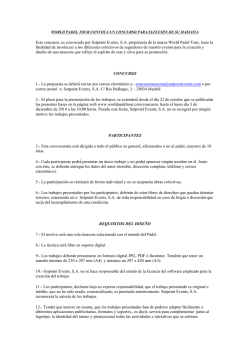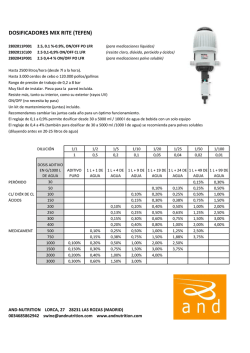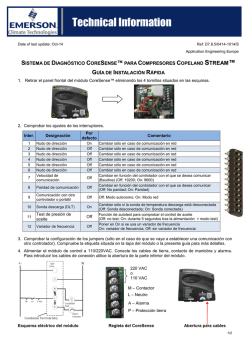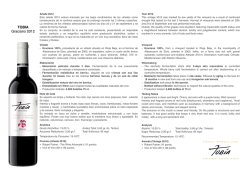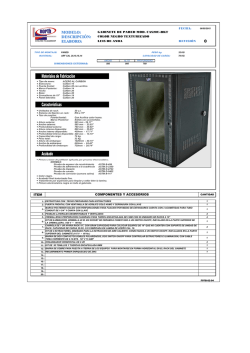
ac1-5 instruction for use
Channel 2 output L1 Channel 1 setpoint modification L2 Channel 2 setpoint modification PAR SCL RANGE SPL SPH 1SP -50°...SPH SPL...150° Maximum limit for 1SP setting. SPL... SPH Setpoint (value to be maintained in the room). 1CM HY; PID Alarm Fig.1 - Front panel Info / Enter button Increase / Modify Setpoint 2 button Modify Setpoint 1 / Decrease button Exit / Stand-by button. INSTALLATION ■■ Insert the controller through a hole measuring 71x29 mm; ■■ Make sure that electrical connections comply with the paragraph “wiring diagrams”. To reduce the effects of electromagnetic disturbance, keep the sensor and signal cables well separate from the power wires. ■■ Fix the controller to the panel by means of the suitable clips, by pressingly gently; if fitted, check that the rubber gasket adheres to the panel perfectly, in order to prevent debris and moisture infiltration to the back of the instrument. ■■ Place the probe T1 inside the room in a point that truly represents the temperature of the stored product. 1CH 1HY 1°C; 2°C; °F REF; HEA 0...19.9° DISPLAY Controller in stand-by Probe T1 overrange or failure Room high temperature alarm Room low temperature alarm TUN/xx.x E1 E2 E3 Controller in autotuning In tuning: timeout1 error In tuning: timeout2 error In tuning: overrange error MENU INFO 1T1 The information available in this menu is: THI Maximum temperature recorded TLO Minimum temperature recorded LOC Keypad state lock 1PB Access to menu and information displayed. ■■ Press and immediately release button . ■■ With button or select the data to be displayed. ■■ Press button to display value. or wait for 10 seconds. ■■ To exit from the menu, press button Reset of THI, TLO recordings ■■ With button or select the data to be reset. ■■ Display the value with button . ■■ While keeping button pressed, use button . CHANNEL 1 SETPOINT (display and modification of desired temperature value) ■■ Press and release button : the LED L1 blinks, the display shows 1SP for 1 second and then the setpoint associated value. ■■ Press buttons or to set the desired value (adjustment is within the minimum SPL and maximum SPH limit). ■■ To store the new value press button , or wait for 10 seconds. ■■ To go back to normal mode without saving the new value, press . 0...30min 0...19.9° 1IT 0...999s 1SP+1HY 1CM=PID 0...999s The keypad lock avoids undesired, potentially dangerous operations, which might be attempted when the controllers is operating in a public place. In the INFO menu, set parameter LOC=YES to inhibit all functions of the buttons. To resume normal operation of keypad, adjust setting so that LOC=NO. Minimum off time. After output 1 has been turned off, it temperature value measured. T[°] 1SP Minimum on time. (the following parameter will be 1PF). After output 1 has been turned on, it remains active for 1T1 minutes regardless of the temperature value measured. Proportional bandwidth. Overshoot Steady-state error 1PB Process temperature Time Integral action time. 1SP Alarm threshold management. NON: all temperature alarms are inhibited (the following parameter will be SB). ABS: the values programmed in ALA and AHA represent the real alarm thresholds. REL: the values programmed in ALR and AHR are alarm differentials referred to 1SP and 1SP+1HY. ON T[°] 1PBx1AR% 1PB integral control action area Process temperature Derivative action time. 1SP 1SP+1HY+AHR 1SP-1HY-ALR 1SP+AHR 1SP Temperature alarm with relative thresholds, heating control (ATM=REL, 1CH=HEA). Relay outputs (AC1-5..R..) OUT1 OUT2 12(4)A 7(2)A SSR drive (AC1-5..M..) OUT1 15mA 12Vdc Inputs see table of input specifications Measurement range see table of input specifications Measurement accuracy see table of input specifications ALA -50°...AHA Low temperature alarm threshold. Operating conditions AHA ALA...150° High temperature alarm threshold. CE (Reference Norms) ALR -12.0...0° Low temperature alarm differential. With ALR=0 the low temperature alarm is excluded AHR 0...12.0° High temperature alarm differential. With AHR=0 the high temperature alarm is excluded 0...120min SB INP NO/YES -10 … +50°C; 15%...80% U.R. EN60730-1; EN60730-2-9; EN55022 (Class B); EN50082-1 Front protection IP55 Delay before alarm temperature warning. Stand-by button enabling. 0mA/4mA, T1/T2 ST1/SN4 Sensor input selection (see table of input specifications). RLO -19.9...RHI Minimum range value (in the models AC1-5A…, AC1-5I… only) RLO takes the minimum value measured by the transmitter (i.e. the value matching 0V, 0/4mA). RHI RLO...99.9 Maximum range value (in the models AC1-5A…, AC1-5I… only) RHI takes the maximum value measured by the transmitter (i.e. the value matching 1V, 20mA) In the models AC1-5A..., AC1-5J..., AC1-5T... only. -12.5...12.5° Probe T1 offset. TLD 1...30min SIM 0...100 Display slowdown ADR 1...255 AC1-5 address for PC communication Delay for minimum temperature (TLO) and maximum temperature (THI) logging. 1PF NON; THR; AL0; AL1 AUX output operation. NON : output disabled (always off). (the next parameter will be ATM) THR: output programmed for second thermostat control (the next parameter will be 2SM). AL0: contacts open when an alarm condition occurs (the next parameter will be ATM). AL1: contacts make when an alarm condition occurs (the next parameter will be ATM). ABS; REL Setpoint 2 mode. Channel 2 setpoint may be absolute (2SM=ABS), or a differential relative to setpoint 1 (2SM=REL) RLO÷RHI [< ± 0.2mA] --- 4÷20mA INP=T1 TC “J” --- -50÷750°C [ < ±3°C ] INP=T2 TC “K” --- -50÷999°C [ < ±3°C ] -50/-19.9÷99.9/150°C [ < ±0.3°C ] -100÷850°C [ <±1°C(-50÷850°), ±2°C ] -150÷999°F [ <±2°F(-60÷999°), ±4°F] PT100 -60÷999°F [ < ±5°F ] INP=ST1 PTC 1000 Ω (LAE ST1..) -50/-19.9 ÷ 99.9/150°C [<±0.3°C(-30÷130°),±1°C] -50 ÷ 150°C [<±0.3°C(-30÷130°), ±1°C] -60 ÷ 300°F [< ±0.6°F(-20÷260°),±2°F] INP=SN4 NTC 10K Ω (LAE SN4..) -40/-19.9 ÷ 99.9/125°C [<±0.3°C(-40÷100°),±1°C] -40 ÷ 125°C [<±0.3°C(-40÷100°),±1°C] -40 ÷ 260°F [<±0.6°F(-40÷210°), ±2°F] AC1-5T... OAU --- INP = 4mA 1PB ON/OFF SCL=°F 0÷20mA AC1-5P... Cycle time. It’s the period in which the output ON time changes. The quicker the system to be controlled reacts to temperature variations, the smaller the cycle time must be, in order to obtain higher temperature stability and less sensitivity to load variations. SCL=2°C RLO÷RHI [< ± 3mV] INP = 0mA AC1-5J... 1...255s SCL=1°C 0÷1V AC1-5I... 1SP RANGE [MEASUREMENT ACCURACY] INPUT Overshoot Process temperature T[°] OFF Temperature alarm with relative thresholds, refrigerating control (ATM=REL, 1CH=REF) AC1-5A... 1CT 2SM=ABS Auxiliary output state in case of probe failure. NON; ABS; REL 1SP-ALR WIRING DIAGRAMS V RS485 TTL rH 9 10 11 V+ VIN V- data I/O OUT1 12(4)A Output state in case of probe failure. 1 2 OUT2 7(2)A 3 4 5 OUT1 12(4)A 6 7 115...230V~ 1 AC1-5AS2RW-B 10 + data I/O 2 11 - OUT2 7(2)A 3 4 5 6 7 115...230V~ AC1-5JS2RW-A Auxiliary output switchover temperature (the next parameter will be 2CH) ON RS485 ON OFF 2SP 2SP+2HY T[°] OFF ON/OFF control in refrigeration (2SM=ABS, 2CH=REF) T[°] ON/OFF control in heating (2SM=ABS, 2CH=HEA) 2DF -19.9...19.9° Temperature differential relative to 1SP. The auxiliary output setpoint is equal to 1SP+2DF ON ON TTL 9 10 11 W R W data I/O 2SP-2HY 2SP OUT1 15mA OAU=THR ON/OFF MODEL Time 2SM=REL 2PF ATM AC1-5…D 12Vac/dc ±10%, 2W AC1-5...W 110 - 230Vac±10%, 50/60Hz, 2W INPUT SPECIFICATIONS Reset of integral action time referred to 1PB Decreasing the parameter 1AR reduces the integral control action zone, and consequently the overshoot (see figure on paragraph 1IT). SPL...SPH Minimum on time. After output 2 has been turned on, it remains active for 2T1 minutes regardless of the temperature value measured. Overshoot 0...100% 2SP Power supply Minimum off time. After output 2 has been turned off, it remains inactive for 2T0 minutes regardless of the temperature value measured. 0...30min OS1 1SP 1AR 2SM Differential of thermostat 2. With 2HY=0 the auxiliary output always remains off. 2T1 ATD remains inactive for 1T0 minutes regardless of the CONTROLLER AUTOTUNING IN PID MODE ■■ Have a precision reference thermometer or a calibrator to hand. Ensure that OS1=0 and SIM=0. ■■ Switch the controller off then on again. ■■ During the auto-test phase, press buttons + and keep them pressed till the controller shows 0AD. ■■ With buttons and select 0AD or SAD: 0AD allows a calibration of 0, inserting a constant correction over the whole scale of measurement. SAD allows a calibration of the top part of the measurement scale with a proportional correction between the calibration point and 0. ■■ Press to display the value and then use + or to make the read value coincide with the value measured by the reference instrument. ■■ Exit from calibration by pressing button . 1SP-1HY ON/OFF heating control (1CM=HY, 1CH=HEA) Response overshoot may be reduced by inserting a derivative Action. A high derivative action (1DT high) makes the system very sensitive to small temperature variations and causes instability. With 1DT=0 the derivative control is disabled. KEYPAD LOCK RECALIBRATION OFF T[°] Time , when pressed for 3 seconds, allows the controller to be put on a standby or output control to be resumed (with SB=YES only). Before starting In the setup mode (see configuration parameters): set 1CM=PID; make sure that 1CH matches the desired operation mode (1CH=REF for refrigerating control, 1CH=HEA for heating control); then adjust setpoint 1SP at the desired value. Start autotuning During normal operation, keep buttons + pressed for 3 seconds. 1CT blinks on the display. With + or set the cycle time in order to define the dynamic of the process to be controlled. To abort the autotuning function, press ; to start autotuning press + or wait for 30 seconds. During autotuning During the entire autotuning phase, the display alternates TUN with the actual temperature measured. In case of power failure, when power is resumed, after the initial autotest phase, the controller resumes the autotuning function. To abort the autotuning, without modifying the previous control parameters, keep button pressed for 3 seconds. After the autotuning has taken place successfully, the controller updates the control parameters and start to control. Errors If the autotuning function failed, the display shows an error code: ■■ E1 timeout1 error: the controller could not bring the temperature within the proportional band. Increase 1SP in case of heating control, vice versa, decrease 1SP in case of refrigerating control and re-start the process. ■■ E2 timeout2 error: the autotuning has not ended within the maximum time allowed (1000 cycle times). Re-start the autotuning process and set a longer cycle time 1CT. ■■ E3 temperature overrange: check that the error was not caused by a probe malfunction, then decrease 1SP in case of heating control, vice versa increase 1SP in case of refrigerating control and then re-start the process. ■■ To eliminate the error indication and return to the normal mode, press button . Control improvement ■■ To reduce overshoot, reduce the integral action reset 1AR ■■ To increase the response speed of the system, reduce the proportional band 1PB. Caution: doing this makes the system less stable. ■■ To reduce swings in steady-state temperature, increase the integral action time 1IT; system stability is thus increased, although its response speed is decreased. ■■ To increase the speed of response to the variations in temperature, increase the derivative action time 1DT. Caution: a high value makes the system sensitive to small variations and it may be a source of instability. OAU=THR ON The steady-state error is cancelled by inserting an integral action. The integral action time, determines the speed with which the steady-state temperature is achieved, but a high speed (1IT low) may be the cause of overshoot and instability in the response. With 1IT=0 the integral control is disabled. 1DT STAND-BY Button OFF/ON thermostat differential. With 1HY=0 the output is always off. Temperature control takes place by changing the ON time of the output: the closer the temperature to the setpoint, the less time of activation. A small proportional band increases the promptness of response of the system to temperature variations, but tends to make it less stable. A purely proportional control stabilises the temperature within the proportional band but does not cancel the deviation from setpoint. With 1PB=0 the output is always off. CHANNEL 2 SETPOINT ■■ With the auxiliary output set as thermostat control (OAU=THR), it’s possible to modify setpoint 2 during the normal operation of the controller. ■■ Press and release button : the LED L2 blinks, the display shows 2SP for 1 second if setpoint 2 is an absolute threshold (2SM=ABS), alternatively the display shows 2DF, if setpoint 2 is a threshold relative to setpoint 1 (2SM=REL), then the value associated to the parameter appears. ■■ Press buttons or to set the desired value. ■■ To store the new value press button or wait for 10 seconds. ■■ To go back to normal mode without saving the new value, press . Refrigerating (REF) or Heating (HEA) control mode. ON/OFF refrigerating control (1CM=HY, 1CH=REF) 0...30min 0...19.9° 0...30min 2HY 2T0 OFF Control mode. With 1CM=HY you select control with hysteresis: parameters 1HY, 1T0 and 1T1 are used. With 1CM=PID you select a Proportional-Integral-Derivative control mode: parameters 1PB, 1IT, 1DT, 1AR, 1CT will be used 1SP 1T0 TECHNICAL DATA REF; HEA ON OFF 1CM=HY OFF OR HI LO Refrigerating control (REF) or heating control mode (HEA) for the auxiliary output. 2CH Minimum limit for 1SP setting ON OPERATION During normal operation, the display shows either the temperature measured or one of the following indications: DESCRIPTION Readout scale (see table of input specifications) Caution: upon changing the SCL value, it is then absolutely necessary to reconfigure the parameters relevant to the absolute and relative temperatures (SPL, SPH, 1SP, 1HY etc..) ATM=ABS OUT2 ATM=REL OUT1 Channel 1 output Temperature INDICATION DESCRIPTION ■■ To get access to the parameter configuration menu, press button + for 5 seconds. ■■ With button or select the parameter to be modified. ■■ Press button to display the value. ■■ By keeping button pressed, use button or to set the desired value. ■■ When button is released, the newly programmed value is stored and the following parameter is displayed. ■■ To exit from the setup, press button or wait for 30 seconds. Temperature Thank you for having chosen a LAE electronic product. Before installing the instrument, please read these instructions carefully to ensure maximum performance and safety. CONFIGURATION PARAMETERS Temperature AC1-5 INSTRUCTION FOR USE 1 - 12V 2 SSR OUT2 7(2)A 4 5 OUT1 12(4)A 6 7 10 data I/O 1 2 11 OUT2 7(2)A 3 4 5 6 7 + OFF OFF 1SP+2DF+2HY 2DF>0 1SP 1SP+2DF T[°] ON/OFF control in refrigeration. Setpoint 2 relative to setpoint 1 (OAU=THR, 2CH=REF) 1SP+2DF-2HY 2DF<0 1SP+2DF 1SP T[°] ON/OFF control in heating. Setpoint 2 relative to setpoint 1 (OAU=THR, 2CH=HEA) 115...230V~ AC1-5PS2MW-B 115...230V~ AC1-5TS2RW-A VIA PADOVA, 25 31046 ODERZO /TV /ITALY TEL. +39 - 0422 815320 FAX +39 - 0422 814073 www.lae-electronic.com E-mail: [email protected] OUT1 Salida canal 1 OUT2 Salida canal 2 L1 Modificación setpoint canal 1 L2 Modificación setpoint canal 2 Alarma Fig.1 — Panel frontal Botón Info / Enter. Botón aumento / modificación setpoint 2 Botón modificación setpoint 1 / disminución. Botón salida / Stand-by. INSTALACIÓN ■■ Introduzca el instrumento en un agujero de 71x29 mm; ■■ Realice las conexiones eléctricas tomando como referencia el párrafo “esquemas de conexión”. Para reducir los efectos de las perturbaciones electromagnéticas, aleje los cables de las sondas y de señal de los conductores de potencia ■■ Fije el instrumento al panel con las abrazaderas específicas, presionando correctamente; de estar incluida, la junta de caucho se debe colocar entre el marco del instrumento y el panel, comprobando que quede perfectamente adherida para evitar infiltraciones hacia la parte trasera del instrumento. ■■ Coloque la sonda T1 en un punto de la cámara que tenga perfectamente la temperatura del producto que se ha de conservar. 1°C; 2°C; °F Límite mínimo para la regulación de 1SP. Límite máximo para la regulación de 1SP. SPL... SPH Temperatura de conmutación (valor que se desea mantener en la cámara). 1CM HY; PID 1CH REF; HEA 0...19.9° Instrumento en autocalibración En calibración: error de timeout1 En calibración: error de timeout2 En calibración: error de tolerancia 1CM=HY TUN/xx.x E1 E2 E3 MENÚ INFO Las informaciones disponibles en el menú Info son: THI Temperatura máxima medida sonda 1 TLO Temperatura mínima medida sonda 1 LOC Estado del teclado (bloqueo) Pulsando durante 3 segundos el botón (sólo con SB=YES). T[°] 1SP-1HY 1SP Control ON/OFF en calefacción (1CM=HY, 1CH=HEA) T[°] 0...30min Tiempo mínimo de activación. (El parámetro succesivo será 1PF). Después de una activación la salida 1 se queda activada para 1T1 minudos, con cualquiera temperatura. 1PB 0...19.9° Banda proporcional. 0...999s Temperatura de proceso Tiempo de la acción integral. Sobreelongación Temperatura Temperatura de proceso REF; HEA 2HY 2T0 0...19.9° Diferencial del termóstato 2. Con 2HY=0 la salida auxiliar siempre se queda apagada. 0...30min Tiempo mínimo de apagamiento. Después de un apagamiento, la salida 2 se queda disactivada para 2T0 minudos, a cualquiera temperatura. 2T1 0...30min Tiempo mínimo de activación. Después de una activación la salida 2 se queda activada para 2T1 minutos, a cualquiera temperatura. 2PF ATM ON/OFF 1PBx1AR% 1PB Zona de acción control integral 1PF ON/OFF OAU NON; THR; AL0; AL1 2SM 2SP 2SM=ABS OAU=THR 1...255s ABS; REL SPL...SPH T[°] OFF 1SP 1SP+1HY+AHR 1SP-1HY-ALR 1SP+AHR 1SP Alarma de temperatura con umbrales relativos, en calentamiento (ATM=REL, 1CH=HEA) -50°...AHA Umbral de alarma de baja temperatura. AHA ALA...150° Umbral de alarma de alta temperatura. ALR -12.0...0° Diferencial de alarma de baja temperatura. Con ALR=0 se desactiva la alarma de baja temperatura. AHR 0...12.0° Diferencial de alarma de alta temperatura. Con AHR=0 se desactiva la alarma de alta temperatura. ATD 0...120min Retardo en la señalización de la alarma de temperatura. SB INP NO/YES stand-by. Habilitación del botón 0mA/4mA, T1/T2 ST1/SN4 Selección del sensor en entrada. (ver tablilla características de entrada) RLO -19.9...RHI Alcance mínimo de la escala (solamente en los modeles AC1-5 A..., AC1-5I...). Se asigna a RLO el valor mínimo mesurado con el transmisor (correspondiente a 0V, 0/4mA) RHI RLO...99.9 Alcance máximo de la escala (solamente en los modeles AC1-5A ..., AC1-5I...). Se asigna a RLO el valor máximo mesurado con el transmisor (correspondiente a 1V, 20 mA). solamente en lo modeles AC1-5A..., AC1-5J..., AC1-5T... INSTRUCTIONS FOR USE INSTRUCCIONES DE USO VIA PADOVA, 25 31046 ODERZO /TV /ITALY TEL. +39 - 0422 815320 FAX +39 - 0422 814073 www.lae-electronic.com E-mail: [email protected] -12.5...12.5° Corrección medición sonda T1. TLD 1...30min SIM 0...100 Deceleración pantalla. ADR 1...255 Dirección de AC1-5 para la comunicación con el PC. MODELO Retardo en la memorización de las temperaturas mínimas (TLO) y máximas (THI) alcanzadas. Temperatura de proceso INP = 0mA 0÷20mA INP = 4mA 4÷20mA INP=T1 TC “J” INP=T2 TC “K” AC1-5J... Tiempo de ciclo. Es el período al interior del cual el tiempo de ON de la salida varia. Cuanto más prontamente el sistema que tiene que ser controlado responde a las variaciones de la temperatura, tanto menor tiene que ser el tiempo de ciclo, para obtener más de estabilidad de la temperatura, y menor sensibilidad a las variaciones de cargo. Estado de la salida con sonda defectuosa. Funcionamiento de la salida auxiliar AUX. NON: salida inhabilitada (siempre apagada). (El próximo parámetro será ATM). THR: salida programada como segundo termóstato. (El próximo parámetro será 2SM). AL0: abertura de los contactos cuando se presenta una condición de alarma. (El próximo parámetro será ATM). AL1: Cerrazón de los contactos cuando se presenta una condición de alarma. (El próximo parámetro será ATM). Modalidad setpoint 2 El setpoint 2 puede ser absoluto (2SM=ABS),o un diferencial relativo al setpoint 1(2SM=REL). Temperatura de conmutación de la salida auxiliar (El próximo parámetro será 2CH). SCL=1°C 0÷1V AC1-5I... 1PB RANGO DE MEDICIÓN [PRECISIÓN DE MEDICIÓN] ENTRADA AC1-5A... Reset de la acción integral referido a 1PB. Disminuyendo el parámetro 1AR disminuye la zona de acción del control integral y, por consiguiente, la sobreelongación (véase la figura en el párrafo 1IT). ON ON T[°] CARACTERÍSTICAS ENTRADA Sobreelongación Temperatura 1CT 0...100% Gestión de los umbrales de la alarma. NON: todas las alarmas de temperatura están suspendidas. (El parámetro sucesivo será SB) ABS: Los valores programados en ALA y AHA representan los umbrales reales de alarma REL: Los valores programados en ALR y AHR son los diferenciales de alarma respecto a 1SP y 1SP+1HY ALA SCL=2°C SCL=°F RLO÷RHI [< ± 3mV] --- RLO÷RHI [< ± 0.2mA] --- --- -50÷750°C [ < ±3°C ] -60÷999°F [ < ±5°F ] AC1-5…D 12Vac/dc ±10%, 2W AC1-5...W 110 - 230Vac±10%, 50/60Hz, 2W Salida Relé (AC1-5..R..) OUT1 OUT2 12(4)A 7(2)A -50÷999°C [ < ±3°C ] -100÷850°C [ <±1°C(-50÷850°), ±2°C ] -150÷999°F [ <±2°F(-60÷999°), ±4°F] INP=ST1 PTC 1000 Ω (LAE ST1..) -50/-19.9 ÷ 99.9/150°C [<±0.3°C(-30÷130°),±1°C] -50 ÷ 150°C [<±0.3°C (-30÷130°),±1°C] -60 ÷ 300°F [<±0.6°F (-20÷260°),±2°F] Entradas INP=SN4 NTC 10K Ω (LAE SN4..) -40/-19.9 ÷ 99.9/125°C [<±0.3°C(-40÷100°), ±1°C] -40 ÷ 125°C [<±0.3°C (-40÷100°),±1°C] -40 ÷ 260°F [<±0.6°F (-40÷210°),±2°F] Rango de medición PT100 AC1-5T... ESQUEMAS DE CONEXIÓN OUT1 12(4)A 4 5 7 10 + data I/O OUT1 12(4)A 6 15mA 12Vdc ver la tablilla características entrada ver la tablilla características entrada Condiciones de funcionamiento 9 10 11 V+ VIN VOUT2 7(2)A 3 OUT1 ver la tablilla características entrada TTL rH data I/O Pilotaje SSR (AC1-5..M..) Precisión de medición V RS485 2 Alimentación --- AC1-5P... 1 DATOS TÉCNICOS -50/-19.9÷99.9/150°C [ < ±0.3°C ] Tiempo 1AR Estado de la salida 2 con sonda defectuosa. NON; ABS; REL OS1 Tiempo Tiempo de la acción derivada. La inserción de una acción derivada en un control 1SP proporcional-integral, disminuye la sobreelongación en la respuesta. Una acción derivada alta (1DT alto) hace que el sistema sea muy sensible a las pequeñas variaciones de temperatura y puede conducir a la inestabilidad. Con 1DT=0 el control derivado se desactiva. AUTOCALIBRACIÓN DEL REGULADOR EN MODALIDAD PID 1PB Tiempo La inserción de una acción integral en un control 1SP proporcional anula el error en régimen de funcionamiento. El tiempo de la acción integral determina la velocidad con la que se alcanza la temperatura de régimen de funcionamiento, pero una velocidad alta (1IT bajo) puede causar sobreelongación e inestabilidad en la respuesta. Con 1IT=0 el control integral se desactiva. 0...999s Error en régimen de funcionamiento Sobreelongación El control de la temperatura se realiza variando el tiempo de ON de la salida: más la temperatura 1SP está cerca del setpoint, menor será el tiempo de activación. Una banda proporcional pequeña augmenta la rapidez del sistema en relación a las variaciones de temperatura, pero lo hace menos estable. Un control simplemente proporcional estabiliza la temperatura al interior de la banda proporcional, pero no anula el alejamiento con respecto al setpoint. Con 1PB=0 la salida siempre se queda apagada. T[°] 2CH Alarma de temperatura con umbrales relativos en refrigeración (ATM=REL, 1CH=REF) 1T1 El bloqueo de los botones impide la ejecución de operaciones indeseables, potencialmente perjudiciales, que podrían activarse si el regulador funcionara en lugares abiertos al público. Para inhibir todos los mandos del teclado, configure LOC=YES en el menú INFO; para restablecer la función normal, programe nuevamente LOC=NO. ■■ Procúrese un termómetro de referencia de precisión o un calibrador; Controle que OS1=0 y SIM=0.; ■■ Apague y encienda el instrumento; ■■ Durante la etapa de autotest, pulse los botones + y manténgalos pulsados hasta que el instrumento muestre 0AD; ■■ Con los botones y seleccione 0AD o SAD: 0AD permite regular el 0 insertando una corrección constante en toda la escala de medida. SAD permite regular la parte alta de la escala de medida con una corrección proporcional entre el punto de regulación y el 0. ■■ Pulse para visualizar el valor y utilice + o para hacer coincidir el valor leído con aquel medido por el instrumento de referencia; 1SP+1HY 2DF<0 1SP+2DF 1SP Control ON/OFF en refrigeración. Setpoint 2 relativo al setpoint 1 (OAU=THR, 2CH=REF) Modo de regulación en refrigeración (REF) o calentamiento (HEA) de la salida auxiliar. 1SP-ALR Tiempo mínimo de apagamiento Después de un apagamiento, la salida 1 se queda disactivada para 1T0 minudos, a cualquiera temperatura. BLOQUEO DEL TECLADO RECALIBRACIÓN OFF 1SP+2DF-2HY Control ON/OFF en calefacción. Setpoint 2 relativo al setpoint 1 (OAU=THR, 2CH=HEA) OFF 0...30min 1DT , es posible conmutar el estado del regulador entre las funciones de las salidas y standby Antes de empezar En modalidad setup (ver los parárametros de configuración): asentar 1CM=PID; asegurarse de que 1CH corresponda a la modalidad de funcionamiento deseada (1CH=REF para la refrigeración, 1CH=HEA para la calefacción); fijar el setpoint 1SP al valor deseado. Empezar la función Durante el funcionamento normal, tener pulsadas las teclas + para 3 segundos. En la pantalla relampaguea 1CT, con + o asentar el tiempo de ciclo para poder caracterizar la dinámica del proceso que tiene que ser controlado. Para abandonar la función de autotuning pulsar ; para empezar el autotuning pulsar + o esperar para 30 segundos. Durante la autocalibración Durante toda la etapa de autocalibración la pantalla muestra alternativamente TUN y el valor de la temperatura medida. Si se cortara la alimentación, al volverlo a encender, después de la etapa de autotest inicial, el instrumento reanudará la función de autocalibración. Para abandonar la función de autocalibración sin modificar los parámetros de control, mantenga pulsado durante 3 segundos el botón . Una vez concluida correctamente la autocalibración, el controlador actualizará el valor de los parámetros de control y comenzará a controlar. Errores Si la función de autocalibración no obtuviera resultados positivos, en la pantalla destellará un código de error: ■■ E1 error de timeout1: el controlador no pudo llevar la temperatura dentro de la banda proporcional. Aumente 1SP en el caso de control en calentamiento, viceversa, disminuya 1SP en refrigeración y reactive el procedimiento. ■■ E2 error de timeout2: la autocalibración no ha concluido dentro del tiempo máximo establecido (1000 tiempos de ciclo). Reactive el procedimiento de autocalibración y configure un tiempo de ciclo 1CT mayor. ■■ E3 temperatura fuera del rango: controle que el error no haya sido causado por un desperfecto de la sonda, disminuya 1SP en el caso de control en calentamiento, viceversa, aumente 1SP en refrigeración y reactive el procedimiento. ■■ Para eliminar la indicación de error y volver al modo normal, pulse el botón . Mejoramiento del control ■■ Para reducir la sobreelongación, disminuya el reset de la acción integral 1AR; ■■ Para aumentar la celeridad del sistema, disminuya la banda proporcional 1PB; atención: de esta manera el sistema será menos estable; ■■ Para reducir las oscilaciones de la temperatura en régimen de funcionamiento, aumente el tiempo de la acción integral 1IT; así se aumenta la estabilidad del sistema, pero disminuye su celeridad; ■■ Para aumentar la velocidad de respuesta a las variaciones de temperatura, aumente el tiempo de la acción derivada 1DT; atención: un valor alto hace que el sistema sea sensible a las pequeñas variaciones y puede ser fuente de inestabilidad. OFF T[°] ON 1T0 1CM=PID STAND-BY ON 1SP 1IT 1SP+2DF+2HY 2DF>0 1SP 1SP+2DF Diferencial del termóstato. Con 1HY=0 la salida siempre se queda apagada. ON OFF OFF Modo de regulación en refrigeración (REF) o calentamiento (HEA) de la salida 1. Control ON/OFF en refrigeración (1CM=HY, 1CH=REF) SETPOINT CANAL 2 ■■ Con la salida auxiliar asentada como termóstato (OAU=THR), es posible modificar el setpoint 2 durante el funcionamento normal del regulador. ■■ Pulsar y dejar la tecla : el led L2 relampaguea, la pantalla visualiza para un segundo 2SP, si el setpoint 2 está asentado en modalidad absoluta (2SM=ABS), o visualiza 2DF si el setpoint 2 es relativo al setpoint 1 (2SM=REL), y enseguida el valor asociado al parámetro. o para impostar el valor deseado. ■■ Utilizar las teclas ■■ Para memorizar el nuevo valor pulsar la tecla , o atender 10 segundos. ■■ Para volver a la modalidad normal sin salvaguardar el nuevo valor pulsar . Modalidad de control. Con 1CM=HY se selecciona la regulación con histéresis: en el control se utilizan los parámetros 1HY ,1T0 y 1T1. Con 1CM=PID se selecciona la regulación Proporcional-Integral-Derivada: en el control se utilizan los parámetros 1PB, 1IT, 1DT, 1AR, 1CT. Temperatura Acceso al menú y visualización de las informaciones. . ■■ Pulse y suelte inmediatamente el botón ■■ Con los botones o seleccione el dato que debe visualizar. ■■ Pulse el botón para visualizar el valor. ■■ Para salir del menú, pulse el botón o espere 10 segundos. Reajuste de las memorizaciones THI, TLO ■■ Con los botones o seleccione el dato que debe reajustar. ■■ Visualice el valor con el botón . ■■ Manteniendo pulsado el botón pulse el botón . SETPOINT CANAL 1 (visualización y modificación del valor de temperatura deseado) ■■ Pulsar y dejar la tecla : el led L1 relampaguea, la pantalla visualiza para 1 segundo 1SP y después el valor asociado al setpoint ■■ Utilizar las teclas o para asentar el valor deseado (la regulación está comprendida entre el límite mínimo SPL y máximo SPH). ■■ Para memorizar el nuevo valor pulsar la tecla , o attendere 10s. ■■ Para volver a la modalidad normal sin salvaguardar el nuevo valor pulsar . Escala de lectura (ver la tablilla características entrada) Atención: cambiando el valor de SCL, deberán ser configurados obligatoriamente los parámetros de las temperaturas absolutas y relativas (SPL, SPH, 1SP, 1HY etc..) -50°...SPH Durante el funcionamiento normal, en la pantalla se visualiza la temperatura medida, o bien una de las siguientes indicaciones: Regulador en standby Fuera de tolerancia o rotura T1 Alarma de alta temperatura en cámara Alarma de baja temperatura en cámara DESCRIPCIÓN SPL...150° VISUALIZACIONES OFF OR HI LO . SPL SPH 1SP 1HY FUNCIONAMIENTO RANGO + ON ON 2SM=REL ■■ Para acceder al menú de configuración de los parámetros, pulse durante 5 segundos los botones ■■ Con los botones o seleccione el parámetro que deba modificar. ■■ Pulse el botón para visualizar el valor. ■■ Manteniendo pulsado el botón , utilice los botones o para configurar el valor deseado. ■■ Al soltar el botón el nuevo valor será memorizado y se visualizará el parámetro siguiente. ■■ Para salir del setup, pulse el botón o espere 30 segundos. PAR SCL AC1-5 2DF -19.9...19.9° Diferencial de temperatura con respecto a 1SP. El setpoint de la salida auxiliar corresponde a 1SP+2DF OAU=THR INDICACIONES DESCRIPCIÓN . ATM=ABS Les agradecemos por la preferencia demostrada eligiendo un producto LAE electronic. Antes de comenzar con la instalación del instrumento, lea detenidamente estas instrucciones para así obtener el mejor rendimiento y seguridad. ■■ Para salir de la calibración, pulse el botón PARÁMETROS DE CONFIGURACIÓN ATM=REL AC1-5 INSTRUCCIONES DE USO 1 2 -10 … +50°C; 15%...80% H.R. 11 - CE (Normativas de referencia) OUT2 7(2)A 3 4 5 EN60730-1; EN60730-2-9; EN55022 (Clase B); EN50082-1 6 Protección frontal 7 IP55 ON OFF 2SP 2SP+2HY T[°] Control ON/OFF en refrigeración (2SM=ABS, 2CH=REF) OFF 115...230V~ 2SP-2HY 2SP T[°] Control ON/OFF en calefacción (2SM=ABS, 2CH=HEA) AC1-5AS2RW-B 115...230V~ AC1-5JS2RW-A AC1-5 INSTRUCTIONS FOR USE EN INSTRUCCIONES DE USO ES 0LAC1001-02
© Copyright 2025

